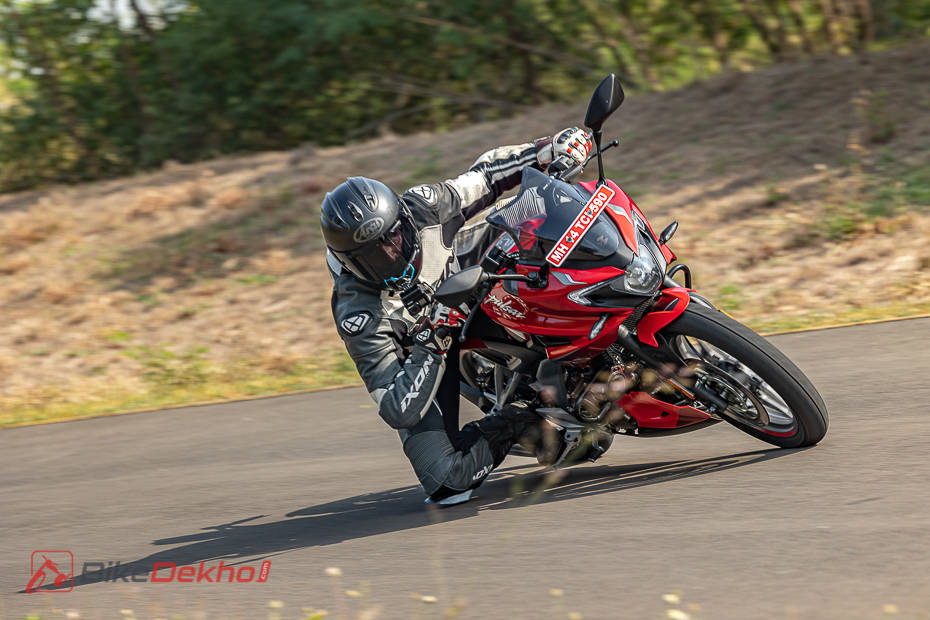Bajaj Pulsar F250: Review In Images
Published On November 7, 2021 12:55 IST
By Pratik Bhanushali for Bajaj Pulsar F250
- 2365 Views
Here’s how the largest Pulsar is more of an evolution rather than a revolution

Been around for a decade and to be rightly said, the Bajaj Pulsar has become a brand in itself. From first time buyers to the ones upgrading, the Pulsar lineup has left a stamp in the Indian two-wheeler industry. But, in the past few years, Bajaj’s focus on KTM seems to have dulled the fastest Indians brightness. However, Bajaj has now attempted to reignite the spark with the Pulsar 250 twins. So, let's see what the Pulsar F250 is like in these detailed images.

While the design approach on the Pulsar F250 is fairly fresh, one can’t overlook the presence of the Pulsar 220 F elements in the half fairing. It’s the same story with the central projector unit with boomerang-like LED DRLs, we aren’t complaining. The screen is tall and wide and the mirrors are very useful as well.

Even though the aesthetics of the Pulsar F250 are likeable, we’d prefer a bit more toned down approach with the graphics around.

Moving to the rear end, the split LED tail section reminds us of the Dominar 400. Even the split seat format is very likeable. However, the small two-port exhaust is what disturbs the proportions.

As for the features, Bajaj has continued with the part-analogue display on the Pulsar F250 as well. Dubbed as the infinity console because of its slim bezel, the cluster gets an analogue dial housing the tachometer at the centre.

Apart from LED illumination, the most modern features that you’d see from Bajaj are a gear position indicator (along the real time fuel efficiency and total range) on the LCD and a USB charging port. With the Bluetooth connectivity and turn-by-turn navigation skipped, it’s a big miss from the bikemaker in our books.

The 249.07cc air-cooled motor with an oil-cooler is a brand new unit and isn’t borrowed from the Dominar 250. It not only makes the most torque (of all Pulsars) on paper but also reflects the same in the real world.

Off-the line pulls are sprightly without any signs of struggle. The mid-range performance is impressive and the ample torque is on display when you ride the bike in a higher gear. City commutes too are easy in 3rd-4th gear and making it even more comfortable is the light clutch action.

We found the 5-speed transmission to be sufficient and slick. However, moving to the 3rd gear needs more attention at times.

The speedometer indicated a top speed of 145kmph at the test track while the V-Box verified it to be 135kmph, good job! There’s enough punch at the top-end too for those who want to tour with the new Pulsar F250. The refinement levels are way better than the predecessor, the Pulsar 220 F, but not as much compared to the foes in the segment. We still sensed a bit of buzz from the handlebar, footpegs and seat, nothing startling though.

With the 14-litre fuel tank and a claimed 39kmpl fuel efficiency, you can expect a good 550km of range.

The clip-on handlebar paired with the mildly rearset footpegs makes for a sporty demeanour. However, this doesn’t interfere with the overall comfort of the rider triangle. The seat height too is fairly low at 795mm and the narrow cushion makes it feasible for shorter riders.

Bajaj has employed a new steel tubular frame which offers more stiffness and is lighter than the perimeter chassis seen on the Pulsar NS200.

Even the wheels are 1kg lighter but all these weight savings and the F250 is still the heftiest Pulsar.

On the Chakan track, we found the bike to be easy to steer and overall the Pulsar F250 was quite planted throughout. The precision isn’t as sharp as the Yamaha YZF R15 but individually, the Pulsar F250 does a good job.

Meanwhile, the suspension setup is very pliant and absorbs most of the undulations. It’s only the sharp bumps that monoshock can’t deal with very well.

The Grimeca braking setup offers a good bite and lever feel with not too much intrusion from the ABS. However, we are disappointed that the Pulsar F250 doesn’t get dual-channel ABS.

In the past, Bajaj has had a tough time with the quality aspect of the Pulsars. While it has seen gradual progress, the Pulsar F250 still has inconsistent panel gaps, exposed wires and the fit and finish aren’t worthy of your hard earned Rs 1.40 lakh.

On the bright side, the welds and the paint finish are decent. Bajaj mentioned that the bikes we rode were pre-production units and hence the errors.
To conclude, the Bajaj Pulsar F250 definitely makes more sense than the Pulsar 220 F since it’s well rounded in terms of performance, comfort and overall value for money.
